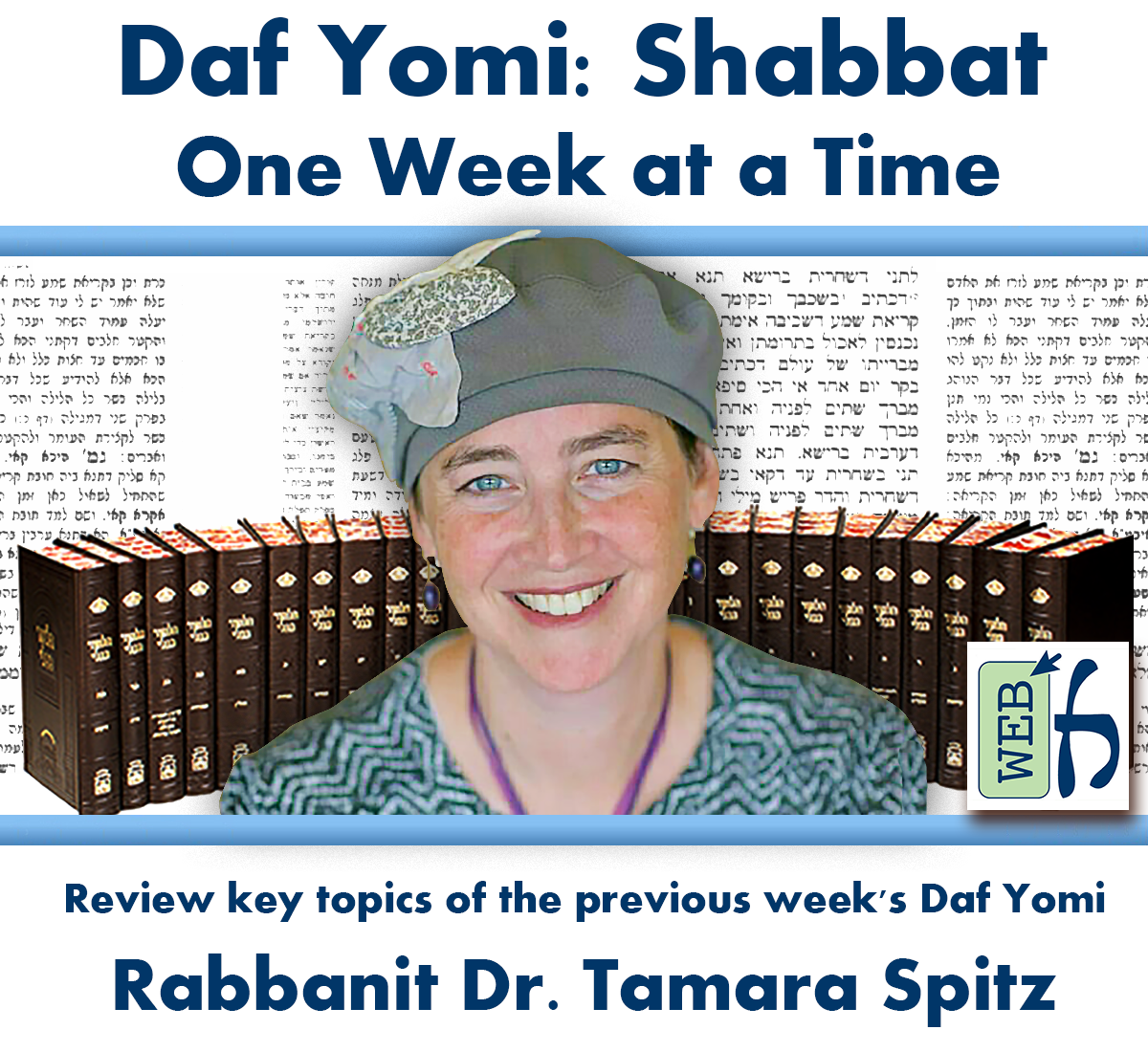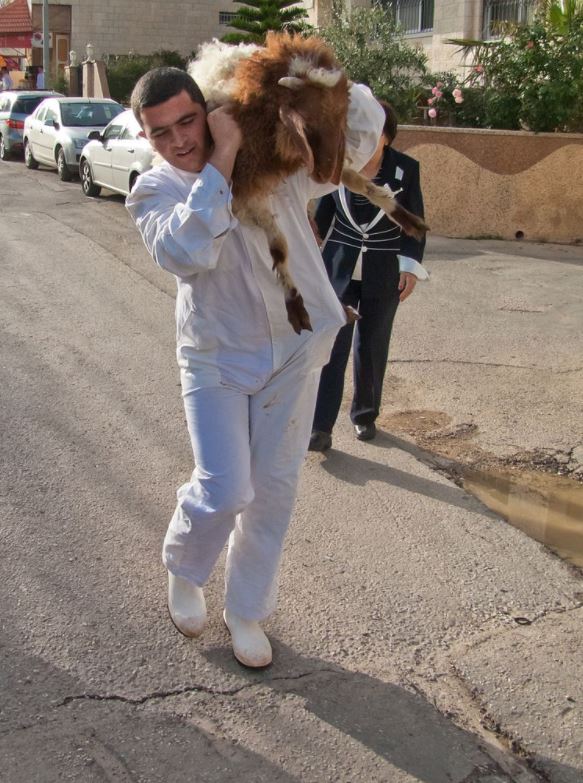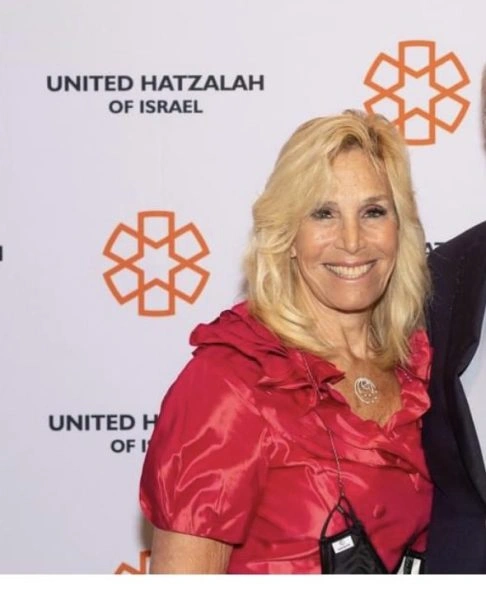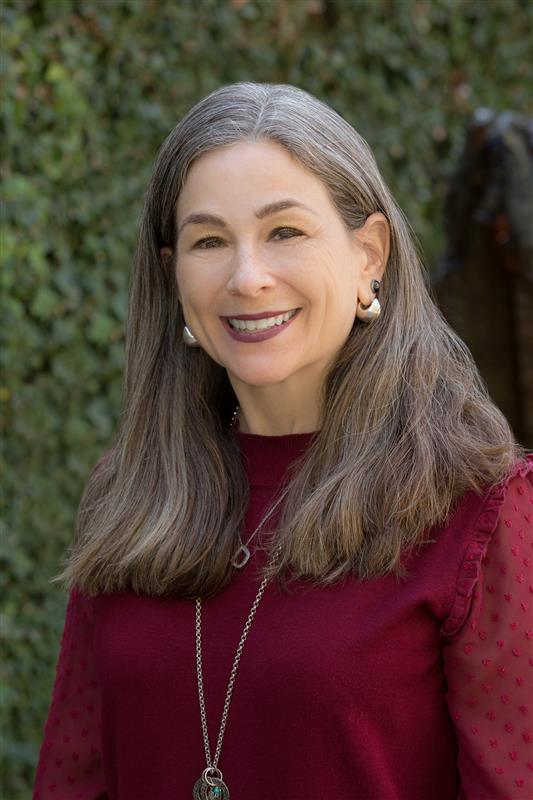Pesachim 74
מַתְנִי׳ כֵּיצַד צוֹלִין אֶת הַפֶּסַח? מְבִיאִין שַׁפּוּד שֶׁל רִמּוֹן, וְתוֹחֲבוֹ לְתוֹךְ פִּיו עַד בֵּית נְקוּבָתוֹ, וְנוֹתֵן אֶת כְּרָעָיו וְאֶת בְּנֵי מֵעָיו לְתוֹכוֹ, דִּבְרֵי רַבִּי יוֹסֵי הַגְּלִילִי. רַבִּי עֲקִיבָא אוֹמֵר: כְּמִין בִּישּׁוּל הוּא זֶה, אֶלָּא תּוֹלִין חוּצָה לוֹ. אֵין צוֹלִין אֶת הַפֶּסַח לֹא עַל הַשַּׁפּוּד וְלֹא עַל הָאַסְכָּלָא. אָמַר רַבִּי צָדוֹק: מַעֲשֶׂה בְּרַבָּן גַּמְלִיאֵל שֶׁאָמַר לְטָבִי עַבְדּוֹ: צֵא וּצְלֵה לָנוּ אֶת הַפֶּסַח עַל הָאַסְכָּלָא.
MISHNA: How does one roast the Paschal lamb? One brings a spit [shappud] of pomegranate wood and thrusts it into the mouth of the lamb until it reaches its anus, and one then puts its legs and entrails inside it and roasts it all together; this is the statement of Rabbi Yosei HaGelili. Rabbi Akiva says: One does not insert its legs and entrails inside it, as this is a type of cooking. Anything placed inside the offering does not get roasted directly by the fire and is considered to have been cooked. Rather, one suspends the legs and entrails from the spit above the animal’s head outside it. One may not roast the Paschal lamb on the metal spit nor on a metal grill [askela]. However, Rabbi Tzadok said: There was an incident with Rabban Gamliel, who said to his slave Tavi: Go and roast the Paschal lamb for us on the grill.
גְּמָ׳ וְנַיְתֵי שֶׁל מַתֶּכֶת? אַיְּידֵי דְּחַם מִקְצָתוֹ חַם כּוּלּוֹ, וְקָמִטְּוֵי מֵחֲמַת הַשַּׁפּוּד, וְרַחֲמָנָא אָמַר ״צְלִי אֵשׁ״, וְלֹא צָלִי מֵחֲמַת דָּבָר אַחֵר. וְנַיְתֵי שֶׁל דֶּקֶל? אַיְּידֵי דְּאִית לֵיהּ שִׁיבֵּי, מַפֵּיק מַיָּא וְהָוֵי כִּמְבוּשָּׁל. וְנַיְתֵי שֶׁל תְּאֵנָה? אַיְּידִי דִּמְחַלְחֵל, מַפֵּיק מַיָּא וְהָוֵה לֵיהּ כִּמְבוּשָּׁל.
GEMARA: The Gemara suggests: Let them bring a metal spit. The Gemara answers: With regard to a metal utensil, once part of it is hot, it is all hot, and the meat is roasted due to the heat of the spit. And the Merciful One states in the Torah that the Paschal lamb must be roasted in fire and not roasted through something else. The Gemara asks why it is necessary to use specifically a spit of pomegranate wood: Let them bring a spit of palm wood. The Gemara answers: Since the palm branch has grooves between the leaves, it gives off a small amount of water from the grooves during roasting. The meat of the offering that touches the spit is as though it is cooked. The Gemara suggests: Let them bring a spit of fig wood. The Gemara answers: Since it is hollow and has sap inside, it gives off water, and it is as though the meat is cooked.
וְנַיְתֵי שֶׁל אַלּוֹן, שֶׁל חָרוּב, וְשֶׁל שִׁקְמָה? אַיְּידֵי דְּאִית בֵּיהּ קִיטְרֵי, מַפֵּיק מַיָּא.
The Gemara suggests: Let them bring a spit made from an oak or from a carob tree or from a sycamore, which are hard and do not have sap. The Gemara answers: With regard to each one of these trees, since it has knots and one must cut them off in order to smooth the branch, it gives off water from the locations of the cuts during roasting, and the meat is considered cooked.
שֶׁל רִמּוֹן נָמֵי אִית בֵּיהּ קִיטְרֵי? שִׁיעִי קִיטְרֵי. וְאִיבָּעֵית אֵימָא: בְּנַבְגָּא בַּר שַׁתָּא, דְּלֵית בֵּיהּ קִיטְרֵי. וְהָא אִיכָּא בֵּי פִסְקֵיהּ! דְּמַפֵּיק לְבֵי פִסְקֵיהּ לְבַר.
The Gemara asks: A branch from a pomegranate tree also has knots. The Gemara answers: Its knots are smooth. There is no need to straighten the branch with a knife in order to use it, and therefore it does not emit water. And if you wish, say that the mishna is referring to a branch within its first year, which does not yet have knots. The Gemara asks: But there is the place it was cut from the tree, and water will come from there. The Gemara answers: One leaves the place it was cut outside of the animal rather than inserting that side of the branch into the animal.
מַתְנִיתִין דְּלָא כְּרַבִּי יְהוּדָה. דְּתַנְיָא, רַבִּי יְהוּדָה אוֹמֵר: כְּשֵׁם שֶׁשַּׁפּוּד שֶׁל עֵץ אֵינוֹ נִשְׂרָף, כָּךְ שַׁפּוּד שֶׁל מַתֶּכֶת אֵינוֹ מַרְתִּיחַ. אָמְרוּ לוֹ: זֶה חַם מִקְצָתוֹ — חַם כּוּלּוֹ, וְזֶה חַם מִקְצָתוֹ — אֵינוֹ חַם כּוּלּוֹ.
The Gemara notes that the mishna is not in accordance with the opinion of Rabbi Yehuda, as it was taught in a baraita that Rabbi Yehuda says: Just as the part of a spit of wood that is inside the animal is not burned, although it is over the fire, so the part of a spit of metal that is inside the animal does not become burning hot. There is no concern that the meat will be roasted from the heat of the spit. The Rabbis said to him: This is not the case. With regard to this, the metal, when part of it is hot, it is all hot. And with regard to that, the wood, when part of it is hot, not all of it is hot, and therefore the meat is cooked by the heat of the fire and not by the heat of the spit.
וְנוֹתֵן אֶת כְּרָעָיו וְכוּ׳. תַּנְיָא: רַבִּי יִשְׁמָעֵאל קוֹרֵיהוּ ״תּוֹךְ תּוֹךְ״. רַבִּי טַרְפוֹן קוֹרֵיהוּ ״גְּדִי מְקוּלָּס״.
It was taught in the mishna that according to the opinion of Rabbi Yosei HaGelili, one places the legs and entrails inside the lamb’s body and roasts them together. It was taught in a baraita: Rabbi Yishmael would call the Paschal lamb: Tokh, tokh, because when one roasts the legs and entrails inside the lamb they make that sound, like other things that are cooked. Rabbi Tarfon would call it: Helmeted kid. In his opinion, the entrails must be roasted when they are suspended from the spit above the head of the animal, somewhat resembling a helmet.
תָּנוּ רַבָּנַן: אֵיזֶהוּ גְּדִי מְקוּלָּס דְּאָסוּר לֶאֱכוֹל בְּלֵילֵי פֶסַח בַּזְּמַן הַזֶּה — כׇּל שֶׁצְּלָאוֹ כּוּלּוֹ כְּאֶחָד! נֶחְתַּךְ מִמֶּנּוּ אֵבֶר, נִשְׁלַק מִמֶּנּוּ אֵבֶר — אֵין זֶה גְּדִי מְקוּלָּס.
The Sages taught: Which is the kid roasted whole that it is prohibited to eat on the nights of Passover in modern times, so as not appear as though one sacrificed the Paschal lamb outside the Temple? It is any kid that one roasted all at once in the manner that the Paschal lamb was roasted. However, if one of its limbs is severed or one of its limbs is boiled, it is no longer considered a kid roasted whole.
הַשְׁתָּא יֵשׁ לוֹמַר נֶחְתַּךְ מִמֶּנּוּ אֵבֶר, דְּאַף עַל גַּב דְּקָא מִטְּוֵי לֵיהּ בַּהֲדֵיהּ, אָמְרַתְּ לָא — נִשְׁלַק מִיבַּעְיָא?! אָמַר רַב שֵׁשֶׁת: שֶׁשְּׁלָקוֹ בִּמְחוּבָּר.
The Gemara expresses surprise at the formulation of this baraita. Now, one can say that if one of its limbs is severed, although one roasts it together with the rest of the animal, you said that it is no longer considered a kid roasted whole, and it is permitted in modern times. If one of its limbs is severed and boiled, which is not an approved method of preparation of the Paschal lamb, is it necessary to say that that it is not considered roasted whole? Rav Sheshet said: This is referring to a case where one boiled the limb while it was attached to the rest of the animal. The halakha teaches that even if the animal remains whole, if one of its limbs is cooked it is no longer considered a kid roasted whole.
אָמַר רַבָּה: הַאי מוּלַיְיתָא — שַׁרְיָא. אֲמַר לֵיהּ אַבָּיֵי: וְהָא קָא בָּלַע דְּמָא! אֲמַר לֵיהּ: כְּבוֹלְעָהּ כָּךְ פּוֹלְטָהּ.
The Gemara raises a general halakhic discussion related to the mishna. Rabba said: This stuffing of raw meat inside another animal that is being roasted is permitted, even if the meat that is stuffed inside has not been salted to remove the blood. Abaye said to him: But the meat of the animal being roasted absorbs blood from the stuffing. He said to him: As it absorbs it, so it then emits it. The heat of the fire causes blood to be released from the meat used as stuffing into the meat of the animal being stuffed, and the heat then draws the blood out of that meat as well.
נֵימָא מְסַיַּיע לֵיהּ: נוֹתֵן אֶת כְּרָעָיו וְאֶת בְּנֵי מֵעָיו לְתוֹכוֹ. מַאי טַעְמָא — לָאו מִשּׁוּם דְּאָמְרִינַן כְּבוֹלְעוֹ כָּךְ פּוֹלְטוֹ? אָמְרִי: שָׁאנֵי הָתָם, כֵּיוָן דְּאִיכָּא בֵּית הַשְּׁחִיטָה דִּמְחַלְחֵל,
The Gemara suggests: Let us say that this mishna supports him: He places its legs and its entrails inside the Paschal lamb and roasts them together. What is the reason that it is permitted to do this? Is it not because we say: As it absorbs it, so it emits it? Although Rabbi Akiva disputes this statement, his opinion is due to the unique halakhot of the Paschal lamb. It seems that everyone agrees that there is no concern about the prohibition against consuming blood. The Gemara refutes this proof: Say it is different there, in the case of the Paschal lamb. Since there is the place of the slaughter, which is hollow and open,
מֵידָב דָּיְיבִי.
the blood flows out. However, in the case of regular stuffing, which is closed on all sides, there is no way for the blood to drain.
נֵימָא מְסַיַּיע לֵיהּ: הַלֵּב, קוֹרְעוֹ וּמוֹצִיא אֶת דָּמוֹ. לֹא קְרָעוֹ — קוֹרְעוֹ לְאַחַר בִּישּׁוּלוֹ, וּמוּתָּר. מַאי טַעְמָא — לָאו מִשּׁוּם דְּאָמְרִינַן כְּבוֹלְעוֹ כָּךְ פּוֹלְטוֹ?
The Gemara suggests further: Let us say that the following mishna supports him: With regard to the heart of an animal, one must tear it and remove its blood before one roasts or cooks it. And if he did not tear it beforehand, he tears it after it is cooked, i.e., roasted, and it is permitted. What is the reason the heart is permitted although there is presumably still blood inside? Is it not because we say that as it absorbs it, so it emits it, and therefore as the heart is roasted the blood is absorbed in the meat and then discharged, so that no blood is left in the meat, and whatever is still inside the hollow part of the heart can be removed when it is torn open? This would support the opinion of Rabba.
שָׁאנֵי לֵב, דְּשִׁיעַ.
The Gemara refutes the proof: A heart is different because it is smooth and does not absorb much blood. However, generally one does not necessarily rely on the principle that as it absorbs it so it emits it.
(אִינִי) וְהָא רָבִין סָבָא טַפְלֵיהּ הָהִיא בַּר גּוֹזָלָא לְרַב, וַאֲמַר לֵיהּ: אִי מְעַלֵּי טִפְלֵיהּ, הַב לִי וְאֵיכוֹל! הָהִיא בִּסְמִידָא דְּמִפְּרִיר.
The Gemara asks: Is that so? Didn’t Ravin the Elder wrap a particular young dove in dough for Rav and roast it, and Rav said to him: If its dough tastes good, give me some and I will eat? Apparently, according to Rav, although the breading absorbed blood, it also certainly discharged it during the roasting. The Gemara refutes this point: That incident involved fine flour [semida], which is crumbly and allows the blood to flow through it.
וְהָא רָבָא אִיקְּלַע לְבֵי רֵישׁ גָּלוּתָא וּטְפַלוּ לֵיהּ בַּר אֲווֹזָא, אָמַר: אִי לָא דַּחֲזִיתֵיהּ דְּזִיג כְּזוּזָא חִיוָּרָא, לָא אֲכַלִי מִינֵּיהּ. וְאִי סָלְקָא דַעְתָּךְ ״כְּבוֹלְעוֹ כָּךְ פּוֹלְטוֹ״ — מַאי אִירְיָא כִּי זִיג? אֲפִילּוּ כִּי לָא זִיג, נָמֵי! הָתָם בְּחִיוָּרְתָּא דְּשָׁרִיר.
The Gemara asks: Didn’t Rava happen to come to the house of the Exilarch, and they breaded a young goose for him, and he said: If I had not seen that the breading is as clear as a white, i.e., new, coin, I would not eat from it out of concern that it absorbed some of the blood? And if it should enter your mind to accept the principle that as it absorbs it so it emits it, why note that he ate it particularly because it was clear? Even if it was not clear, it should also be permitted. The Gemara responds: There, it was talking about white flour, which is firm and does not allow the blood to pass through; Rava ate it only because its color indicated that no blood remained in the breading.
וְהִילְכְתָא: דִּסְמִידָא, בֵּין אַסְמֵיק בֵּין לָא אַסְמֵיק — שַׁרְיָא. דְּחִיוָּרְתָּא, אִי זִיג כְּזוּזָא חִיוָּרָא — שַׁרְיָא, אִי לָא — אֲסִיר. דִּשְׁאָר קְמָחִים, אַסְמֵיק — אָסוּר, לָא אַסְמֵיק — שְׁרֵי.
The Gemara concludes: And the halakha is that if one makes the breading of fine flour, whether it turned red from blood or did not turn red, it is permitted. The following rule applies to breading of white flour: If it is clear like a white coin, it is permitted; if not, it is prohibited. With regard to breading of other types of flour, which are not especially firm or crumbly, if the breading turned red, it is prohibited; if it did not turn red, it is permitted.
הַאי מוּלַיְיתָא, מַאן דְּאָסַר — אֲפִילּוּ פּוּמָּא לְתַחַת, וּמַאן דְּשָׁרֵי — אֲפִילּוּ פּוּמָּא לְעֵיל. וְהִילְכְתָא: מוּלַיְיתָא שְׁרֵי, אֲפִילּוּ פּוּמָּא לְעֵיל.
With regard to this meat stuffing in an animal: The one who prohibits one to eat it, Abaye, does so even if the opening is facing downward, allowing the blood to escape more easily. And the one who permits one to eat it, Rabba, does so even if the opening is facing upward. The Gemara concludes: And the halakha is that stuffing is permitted even if the opening is facing upward, in accordance with the lenient opinion.
אוּמְצָא, בֵּיעֵי, וּמִיזְרְקֵי, פְּלִיגִי בַּהּ רַב אַחָא וְרָבִינָא. בְּכׇל הַתּוֹרָה כּוּלָּהּ רַב אַחָא לְחוּמְרָא וְרָבִינָא לְקוּלָּא, וְהִילְכְתָא כְּרָבִינָא לְקוּלָּא. לְבַר מֵהָנֵי תְּלָת דְּרַב אַחָא לְקוּלָּא וְרָבִינָא לְחוּמְרָא, וְהִלְכְתָא כְּרַב אַחָא לְקוּלָּא.
The Gemara quotes a further discussion concerning the topic of blood absorbed in meat and the preparation of meat permitted for eating. The Gemara addresses three cases: Raw meat [umtza] that is eaten without being salted, testicles of an animal, and the large veins of the neck. Rav Aḥa and Ravina disagreed about this. The Gemara points out: In all their discussions about the Torah, whenever there is a dispute between them and there is no explanation as to which of them holds which opinion, the opinion of Rav Aḥa is stringent and the opinion of Ravina is lenient, and the halakha is in accordance with the opinion of Ravina to be lenient. This applies to all their disputes except for these three, in which Rav Aḥa is lenient and Ravina is stringent, and the halakha is in accordance with the opinion of Rav Aḥa to be lenient.
הַאי אוּמְצָא דְּאַסְמֵיק, חַתְכֵיהּ וּמַלְחֵיהּ — אֲפִילּוּ לִקְדֵרָה שְׁרֵי. שַׁפְּדֵיהּ בְּשַׁפּוּדָא — שְׁרֵי, מֵידָב דָּיֵיב. אַחֲתֵיהּ אַגּוּמְרֵי — פְּלִיגִי בַּהּ רַב אַחָא וְרָבִינָא, חַד אָסַר וְחַד שָׁרֵי. מַאן דְּאָסַר, מִצְמָית צָמֵית. וּמַאן דְּשָׁרֵי, מִישְׁאָב שָׁאֵיב. וְהִילְכְתָא: מִישְׁאָב שָׁאֵיב.
The Gemara explains: With regard to this piece of raw meat that became red from the blood inside it, if one cut it and salted it, it is permitted even to cook them in a pot because it is clear that salt removes blood from meat. If one put it on a spit in order to roast it, it is permitted because the blood flows out. With regard to a case where one placed it on coals, Rav Aḥa and Ravina disagreed about the halakha in this case; one prohibited it and one permitted it. The one who prohibited it reasoned that the coals cause the meat to shrivel and harden, trapping the blood inside. And the one who permitted it reasoned that the heat of the coals draws out the blood, leaving only the meat. And the halakha is that the heat of the coals draws out the blood.
וְכֵן בֵּיעֵי, חַתְכִינְהוּ וּמַלְחִינְהוּ — אֲפִילּוּ לִקְדֵרָה שַׁרְיָין. תְּלִינְהוּ בְּשַׁפּוּדָא — שַׁרְיָין, מֵידָב דָּיֵיב. אַחְתִינְהוּ אַגּוּמְרֵי — פְּלִיגִי בֵּיהּ רַב אַחָא וְרָבִינָא, חַד אָסַר וְחַד שָׁרֵי. מַאן דְּאָסַר, מִצְמָית צָמֵית. וּמַאן דְּשָׁרֵי, מִישְׁאָב שָׁאֵיב.
And, so too, with regard to testicles: If one cut them and salted them, they are permitted even to be cooked in a pot. If one hung them on a spit in order to roast them, they are permitted because the blood flows out. With regard to a case where one placed them on coals, Rav Aḥa and Ravina disagreed about this; one prohibited it and one permitted it. The one who prohibited it reasoned that it shrivels, and the one who permitted it reasoned that the heat draws out the blood.
וְכֵן מִיזְרְקֵי חַתְכֵיהּ וּמַלְחֵיהּ — אֲפִילּוּ לִקְדֵרָה שְׁרֵי. תַּלְיֵיהּ בְּשַׁפּוּדָא, בֵּית הַשְּׁחִיטָה לְתַתַּאי — שְׁרֵי, מֵידָב דָּאֵיב. אַחֲתֵיהּ אַגּוּמְרֵי — פְּלִיגִי רַב אַחָא וְרָבִינָא, חַד אָסַר וְחַד שָׁרֵי. מַאן דְּאָסַר, מִצְמָית צָמֵית. וּמַאן דְּשָׁרֵי, מִישְׁאָב שָׁאֵיב. וְהִלְכְתָא: מִישְׁאָב שָׁאֵיב.
And, so too, with regard to large veins: If one cut them and salted them, it is permitted even to cook them in a pot. If one hung them on a spit and the place of the incision of the slaughter is facing downward, it is permitted because the blood flows out. With regard to a case where one placed it on coals, Rav Aḥa and Ravina disagreed about this matter; one prohibited it and one permitted it. The one who prohibited it reasoned that it shrivels, and the one who permitted it reasoned that the heat draws out the blood. And the halakha is that the heat of the coals draws out the blood, and it is permitted.
הַאי אוּמְצָא דְּאַסְמֵיק חַלְיֵיהּ — אֲסִיר. לָא אַסְמֵיק חַלְיֵיהּ — שְׁרֵי. רָבִינָא אָמַר: אֲפִילּוּ לָא אַסְמֵיק נָמֵי חַלְיֵיהּ — אֲסִיר, אִי אֶפְשָׁר דְּלֵית בֵּהּ שׁוּרְיָיקֵי דְּמָא. אֲמַר לֵיהּ מָר בַּר אַמֵּימָר לְרַב אָשֵׁי: אַבָּא מְגַמַּע לֵיהּ גַּמּוֹעֵי. אִיכָּא דְּאָמְרִי: רַב אָשֵׁי גּוּפֵיהּ מְגַמַּע לֵיהּ גַּמּוֹעֵי.
The Gemara raises another discussion with regard to blood absorbed in meat. People would soak raw meat (Tosafot) in vinegar in order to ensure that none of the blood would separate from its original place and prohibit the meat from being eaten, as it is permitted to eat blood that has not separated from its original place. This piece of raw meat, whose vinegar became red due to the blood absorbed in it, is forbidden. If its vinegar did not become red, it is permitted. Ravina said: Even if its vinegar did not become red, it is forbidden; it is impossible that it does not have streaks of blood. Mar bar Ameimar said to Rav Ashi: Father, i.e., Ameimar, would swallow the vinegar and was unconcerned that there may be blood in it. Some say Rav Ashi himself would swallow it.
אֲמַר לֵיהּ מָר בַּר אַמֵּימָר לְרַב אָשֵׁי: אַבָּא, הַאי חַלָּא דְּחָלֵיט בֵּיהּ חֲדָא זִימְנָא, תּוּ לָא תָּאנֵי חָלֵיט בֵּיהּ. מַאי שְׁנָא מֵחַלָּא מַתְמְהָא דְּחָלְטִינַן בֵּיהּ? הָתָם — אִיתֵיהּ
Mar bar Ameimar said to Rav Ashi: The practice of my father, Ameimar, was that with regard to vinegar in which he had soaked meat one time to keep in its blood, he would not soak meat in it again. It could no longer keep the blood in the meat. The Gemara asks: In what way is vinegar that has been used once different from weak vinegar, in which we soak meat without concern that it will be unable to keep the blood in the meat? The Gemara explains: There, the





















